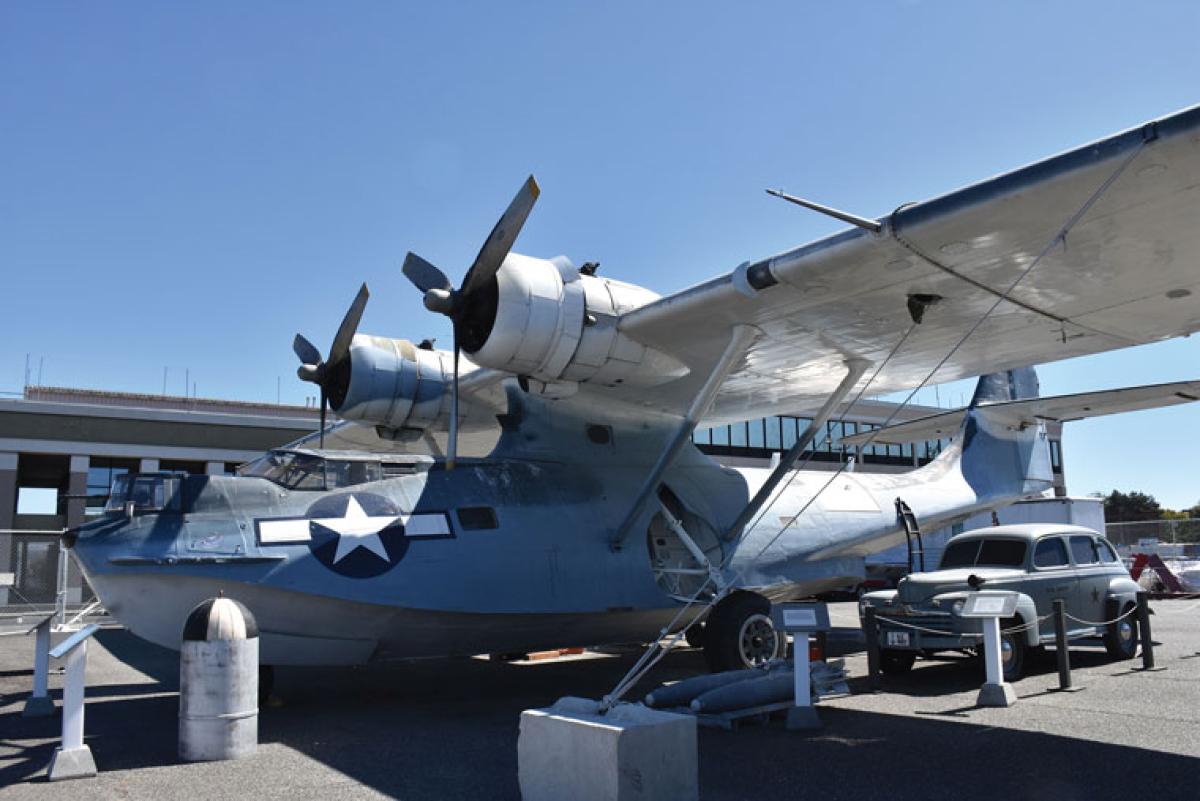The Catalinas helped transform a sleepy town into an active Navy seaplane base during World War II. Today, the PBY-Naval Air Museum brings to the surface the stories of the U.S. Navy, the community of Oak Harbor, and all aircraft that were based at and flown from Naval Air Station Whidbey Island from 1942 to the present day.
The Floating Boat
PBY stands for Patrol Bomber Con-solidated. At 104 feet, the PBY-5A Cata-lina’s wingspan stretches almost half the wingspan of a Boeing 747-8 and demands a lot of space. Currently, Gigi sits outside the museum, exposed to the elements, with several of her parts, such as her nose turret and side blisters, secured in storage until she can be renovated. The museum has plans to build a hangar-style museum and provide on-site restoration opportunities, but is currently in the early stages of the process.
A typical PBY crew consisted of eight men: a pilot, copilot, radioman, navigator, flight engineer, two gunners, and a bombardier/nose gunner. Crews performed over-the-water patrolling, search and rescue, and hunted for submarines. The PBY was an ideal seaplane for such operations because of its long patrol range of 2,500 miles and its ability to carry up to 9,600 pounds of cargo. It could drop 4,000 pounds of bombs, depth charges, or torpedoes, and when painted black it could fly at night virtually undetected. Even though it had no insulation and was fitted with the bare necessities, the PBY held up very well in inclement weather, hence its use in the Aleutian campaign during World War II.
Throughout the war, PBY crews were instrumental in spotting Axis forces and played a pivotal role in locating the German battleship Bismarck and the Japanese fleet at Midway, and rescued downed airmen and survivors of ship sinkings, including men from the USS Indianapolis (CA-35).
The PBY-Naval Air Museum
Inside the museum, displays are a mixture of naval history and local connections, including a pre-Navy exhibit about Whidbey Island’s Native Americans and early pioneers. Stories are told through photographs, artifacts, text, military uniforms, and hands-on activities, including a night-vision room and two flight simulators that allow you to fly a PBY as well as several hundred other aircraft, such as an F4F Wildcat, P-52 Mustang, and B-17 Flying Fortress.
The 11 display areas include a PBY maintenance shop; a MiG-21 tail; 500-pound Mk-82 bombs; collections on the Korean, Vietnam, Gulf, Afghanistan, and Iraq wars; and a very moving Missing Man Table honoring those still missing.
Hands-on exhibits allow visitors to crawl inside the PBY’s nose gun turret. Educational exhibits explain how to identify insignia and test the weight of tail hooks. The video “In the Defense of the Nation” depicts Oak Harbor’s transformation into one of the premier naval aviation facilities in the United States. The area was chosen in part because its deep bay was ideally suited for a seaplane base. Shortly after, an additional airfield opened on nearby coastal farmlands. In a matter of months, the community grew from 350 people to 10,000, enduring hardships along the way, losing prized farmland, but also rallying behind efforts to win the war.
The museum also houses a significant collection of historical documents in its research library, which can be accessed with advance notice.
PBY-Naval Air Museum
270 S. E. Pioneer WayOak Harbor, Washingtonwww.pbymf.org
(360) 840-9500
Hours: Wednesday – Saturday:
1100 to 1700 Sunday: 1300 to 1700
Prices: $7 Adults $6 Seniors and Military Children 6 and under free
Membership: $35 per year (includes free admission to the Museum of Flight in Seattle and the Canadian Museum of Flight in Langley, British Columbia)
The museum gladly accepts donations of naval aviation artifacts, mementos from World War II, or exterior and interior PBY parts.



